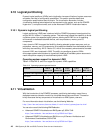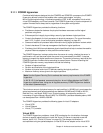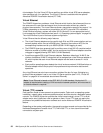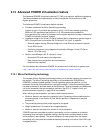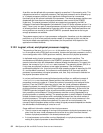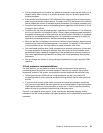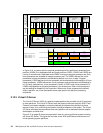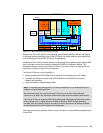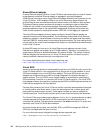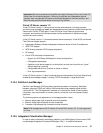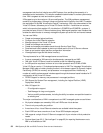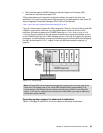Chapter 2. Architecture and technical overview 53
Virtual processors do not introduce any additional abstraction level, they are really only a
dispatch entity. When running on a physical processor, they run at the full speed of the
physical processor.
Each partition’s profile defines a CPU entitlement that determines how much processing
power any given partition should receive. The total sum of CPU entitlement of all partitions
cannot exceed the number of available physical processors in the shared processor pool.
A partition has the same amount of processing power regardless of the number of virtual
processors that it defines.
A partition can use more processing power, regardless of its entitlement, if it is defined as
an
uncapped partition in the partition profile. If there is spare processing power available in
the shared processor pool or other partitions are not using their entitlement, an uncapped
partition can use additional processing units if its entitlement is not enough to satisfy its
application processing demand in the given processing entitlement.
When the partition is uncapped, the number of defined virtual processors determines the
limitation of the maximum processing power it can receive. For example, if the number of
virtual processors is two, then the maximum usable processor units is two.
You are allowed to define more virtual processors than physical processors. In that case,
the virtual processor is waiting for dispatch more often, and you should consider some
performance impact caused by redispatching virtual processors on physical processors.
Also, some applications might benefit from using more virtual processors than physical
processors.
You can change the number of virtual processors dynamically through a dynamic LPAR
operation.
Virtual processor recommendations
For each partition, you can define a number of virtual processors set to the maximum
processing power the partition could ever request. If there are, for example, four physical
processors installed in the system, one production partition and three test partitions, then:
Define the production LPAR with four virtual processors, so that it can receive full
processing power of all four physical processors during the time that the other partitions
are idle.
If you know that the test system never consumes more than one processor computing
unit, then you should define the test system with one virtual processor. Some test systems
might require additional virtual processors, such as four, in order to use idle processing
power left over by a production system during off-business hours.
Figure 2-14 on page 54 shows logical, virtual, and physical processor mapping, and an
example of how the virtual processor and logical processor can be dispatched to the physical
processor.






